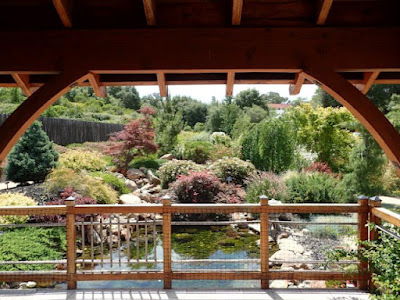
Sherwood Demonstration Garden adds hours, tours

|
|
The Japanese garden is one of the showpieces
of the Sherwood Demonstration Garden in
Placerville. (Photo courtesy El Dorado County
master gardeners)
|
Now that it is March, the El Dorado County master gardeners' beautiful demonstration garden in Placerville has shifted into longer public hours and resumed docent-led tours.
The Sherwood Demonstration Garden is located at the El Dorado Center of Folsom Lake College, 6699 Campus Drive. The garden now is open 9 a.m. to noon every Friday and Saturday through November, unless there is a 60 percent or more chance of rain forecast. (Other closure alerts, more appropriate for summer: A forecast of 95 degrees or more from 9 a.m. to noon, or if air quality level hits 150.)
Master-gardener-led tours are offered on the first Saturday of the month, including this Saturday, March 5. The tours are free, starting promptly at 9 a.m. If no one appears to take the tour, the guide will leave at 9:15 a.m. Group tours can be arranged by emailing mgeldorado@ucanr.edu or calling (530) 621-5512.
What is there to see at Sherwood? So many plants: 16 garden areas, from rock garden to perennials garden, as well as a native plants garden, shade garden, Japanese garden and a children's garden. This link leads to an artistic map of the garden.
Note: No dogs are allowed in the garden. Daily parking passes on the college property are $2. Directions are here .
(Bonus for visitors this Saturday: The Community Observatory also at the El Dorado Center will be open for solar viewing from 10 a.m. to 11:59 a.m. Find out more information here .)
The El Dorado master gardeners also offer free public education classes. An in-person class on "Firewise Landscaping" will be taught by Alice Cantelow on Wednesday, March 9, from 9 a.m. to noon at the Cameron Park Community Center, 2502 Country Club Drive, Cameron Park. Call or email the contacts listed above to register.
-- Kathy Morrison
Comments
0 comments have been posted.Sacramento Digs Gardening to your inbox.
Food in My Back Yard Series
May 6: Maintain soil moisture with mulch for garden success
April 29: What's (already) wrong with my tomato plants?
April 22: Should you stock up on fertilizer? (Yes!)
April 15: Grow culinary herbs in containers
April 8: When to plant summer vegetables
April 1: Don't be fooled by these garden myths
March 25: Fertilizer tips: How to 'feed' your vegetables for healthy growth
March 18: Time to give vegetable seedlings some more space
March 11: Ways to win the fight against weeds
March 4: Potatoes from the garden
Feb. 25: Plant a fruit tree now -- for later
Feb. 18: How to squeeze more food into less space
Feb. 11: When to plant? Consider staggering your transplants
Feb. 4: Starting in seed starting
Sites We Like
Garden Checklist for week of May 11
Make the most of the lower temperatures early in the week. We’ll be back in the 80s by Thursday.
* Plant, plant, plant! It’s prime planting season in the Sacramento area. Time to set out those tomato transplants along with peppers and eggplants. Pinch off any flowers on new transplants to make them concentrate on establishing roots instead of setting premature fruit.
* Direct-seed melons, cucumbers, summer squash, corn, radishes, pumpkins and annual herbs such as basil.
* Harvest cabbage, lettuce, peas and green onions.
* In the flower garden, direct-seed sunflowers, cosmos, salvia, zinnias, marigolds, celosia and asters. (You also can transplant seedlings for many of the same flowers.)
* Plant dahlia tubers.
* Transplant petunias, marigolds and perennial flowers such as astilbe, columbine, coneflowers, coreopsis, dahlias, rudbeckia and verbena.
* Keep an eye out for slugs, snails, earwigs and aphids that want to dine on tender new growth.
* Feed summer bloomers with a balanced fertilizer.
* For continued bloom, cut off spent flowers on roses as well as other flowering plants.
* Add mulch to the garden to maintain moisture. Mulch also cuts down on weeds. But don’t let it mound around the stems or trunks of trees or shrubs. Leave about a 6-inch-to-1-foot circle to avoid crown rot or other problems.
* Remember to weed! Pull those nasties before they set seed.
* Water early in the day and keep seedlings evenly moist.